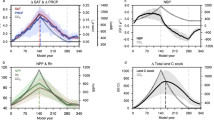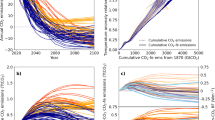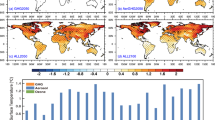Abstract
Short-lived climate forcers (SLCFs) like methane, ozone and aerosols have a shorter atmospheric lifetime than CO2 and are often assumed to have a short-term effect on the climate system: should their emissions cease, so would their radiative forcing (RF). However, via their climate impact, SLCFs can affect carbon sinks and atmospheric CO2, causing additional climate change. Here, we use a compact Earth system model to attribute CO2 RF to direct CO2 emissions and to climate–carbon feedbacks since the pre-industrial era. We estimate the climate–carbon feedback contributed 93 ± 50 mW m−2 (~5%) to total RF of CO2 in 2010. Of this, SLCF impacts were −13 ± 50 mW m−2, made up of cooling (−115 ± 43 mW m−2) and warming (102 ± 26 mW m−2) terms that largely cancel. This study illustrates the long-term impact that short-lived species have on climate and indicates that past (and future) change in atmospheric CO2 cannot be attributed only to CO2 emissions.
This is a preview of subscription content, access via your institution
Access options
Access Nature and 54 other Nature Portfolio journals
Get Nature+, our best-value online-access subscription
$29.99 / 30 days
cancel any time
Subscribe to this journal
Receive 12 print issues and online access
$209.00 per year
only $17.42 per issue
Buy this article
- Purchase on Springer Link
- Instant access to full article PDF
Prices may be subject to local taxes which are calculated during checkout



Similar content being viewed by others
Data availability
Input data used in this paper are all available online from: CDIAC https://cdiac.ess-dive.lbl.gov/trends/emis/meth_reg.html, EDGAR http://edgar.jrc.ec.europa.eu/overview.php?v=42, LUH v1.1 dataset38, IPCC annexes1 https://www.ipcc.ch/report/ar5/wg1/ and Global Carbon Budget42 https://www.globalcarbonproject.org/carbonbudget/index.htm.
Code availability
The code used to generate all the results of this study is available at https://github.com/pkufubo/OSCAR/tree/NCLIM-19122723 (https://doi.org/10.5281/zenodo.3740813). If more information or help about the code is needed, contact the corresponding author.
References
IPCC Climate Change 2013: The Physical Science Basis (eds Stocker, T. F. et al.) (Cambridge Univ. Press, 2013).
Near-term Climate Protection and Clean Air Benefits: Actions for Controlling Short-lived Climate Forcers (UNEP, 2011).
Smith, S. J. & Mizrahi, A. Near-term climate mitigation by short-lived forcers. Proc. Natl Acad. Sci. USA 110, 14202–14206 (2013).
Bowerman, N. H. et al. The role of short-lived climate pollutants in meeting temperature goals. Nat. Clim. Change 3, 1021–1024 (2013).
Haines, A. et al. Short-lived climate pollutant mitigation and the Sustainable Development Goals. Nat. Clim. Change 7, 863–869 (2017).
Friedlingstein, P. et al. Climate–carbon cycle feedback analysis: results from the C4MIP model intercomparison. J. Clim. 19, 3337–3353 (2006).
Heimann, M. & Reichstein, M. Terrestrial ecosystem carbon dynamics and climate feedbacks. Nature 451, 289–292 (2008).
Arneth, A. et al. Terrestrial biogeochemical feedbacks in the climate system. Nat. Geosci. 3, 525–532 (2010).
Le Quéré, C. et al. Saturation of the Southern Ocean CO2 sink due to recent climate change. Science 316, 1735–1738 (2007).
Gasser, T. et al. Accounting for the climate–carbon feedback in emission metrics. Earth Syst. Dynam. 8, 235–253 (2017).
Raupach, M. R. et al. The declining uptake rate of atmospheric CO2 by land and ocean sinks. Biogeosciences 11, 3453–3475 (2014).
Aamaas, B., Berntsen, T. K., Fuglestvedt, J. S., Shine, K. P. & Bellouin, N. Regional emission metrics for short-lived climate forcers from multiple models. Atmos. Chem. Phys. 16, 7451–7468 (2016).
Jones, C. D., Cox, P. M., Essery, R. L., Roberts, D. L. & Woodage, M. J. Strong carbon cycle feedbacks in a climate model with interactive CO2 and sulphate aerosols. Geophys. Res. Lett. 30, 1479 (2003).
Mahowald, N. et al. Desert dust and anthropogenic aerosol interactions in the Community Climate System Model coupled-carbon–climate model. Biogeosciences 8, 387–414 (2011).
Zhang, Y. et al. Increased global land carbon sink due to aerosol-induced cooling. Global Biogeochem. Cycles 33, 439–457 (2019).
Mahowald, N. Aerosol indirect effect on biogeochemical cycles and climate. Science 334, 794–796 (2011).
MacDougall, A. H. & Knutti, R. Enhancement of non-CO2 radiative forcing via intensified carbon cycle feedbacks. Geophys. Res. Lett. 43, 5833–5840 (2016).
Gasser, T. et al. The compact Earth system model OSCAR v2.2: description and first results. Geosci. Model Dev. 10, 271–319 (2017).
Arora, V. K. et al. Carbon–concentration and carbon–climate feedbacks in CMIP5 earth system models. J. Clim. 26, 5289–5314 (2013).
Li, B. et al. The contribution of China’s emissions to global climate forcing. Nature 531, 357–361 (2016).
Shine, K. P., Allan, R. P., Collins, W. J. & Fuglestvedt, J. S. Metrics for linking emissions of gases and aerosols to global precipitation changes. Earth Syst. Dynam. 6, 525–540 (2015).
Andrews, T., Forster, P. M., Boucher, O., Bellouin, N. & Jones, A. Precipitation, radiative forcing and global temperature change. Geophys. Res. Lett. 37, L14701 (2010).
Marvel, K., Schmidt, G. A., Miller, R. L. & Nazarenko, L. S. Implications for climate sensitivity from the response to individual forcings. Nat. Clim. Change 6, 386–389 (2016).
Aas, W. et al. Global and regional trends of atmospheric sulfur. Sci. Rep. 9, 953 (2019).
Mahowald, N. M. et al. Aerosol deposition impacts on land and ocean carbon cycles. Curr. Clim. Change Rep. 3, 16–31 (2017).
Wang, R. et al. Global forest carbon uptake due to nitrogen and phosphorus deposition from 1850 to 2100. Glob. Change Biol. 23, 4854–4872 (2017).
Magnani, F. et al. The human footprint in the carbon cycle of temperate and boreal forests. Nature 447, 849–851 (2007).
Janssens, I. et al. Reduction of forest soil respiration in response to nitrogen deposition. Nat. Geosci. 3, 315–322 (2010).
Sitch, S., Cox, P., Collins, W. & Huntingford, C. Indirect radiative forcing of climate change through ozone effects on the land-carbon sink. Nature 448, 791–794 (2007).
Mercado, L. M. et al. Impact of changes in diffuse radiation on the global land carbon sink. Nature 458, 1014–1017 (2009).
Gu, L. et al. Response of a deciduous forest to the Mount Pinatubo eruption: enhanced photosynthesis. Science 299, 2035–2038 (2003).
Scott, C. et al. Substantial large-scale feedbacks between natural aerosols and climate. Nat. Geosci. 11, 44–48 (2018).
Shen, G. F. et al. Impacts of air pollutants from rural Chinese households under the rapid residential energy transition. Nat. Commun. 10, 3405 (2019).
Ciais, P. et al. Attributing the increase in atmospheric CO2 to emitters and absorbers. Nat. Clim. Change 3, 926–930 (2013).
Gasser, T. et al. Path-dependent reductions in CO2 emission budgets caused by permafrost carbon release. Nat. Geosci. 11, 830–835 (2018).
Boden, T. A., Andres, R. J. & Marland, G. Global, Regional, and National Fossil-Fuel CO2 Emissions (1751–2010) (CDIAC, 2013).
Global Emissions EDGAR v4.2 (EU, 2011); https://doi.org/10.2904/EDGARv4.2
Hurtt, G. C. et al. Harmonization of land-use scenarios for the period 1500–2100: 600 years of global gridded annual land-use transitions, wood harvest, and resulting secondary lands. Clim. Change 109, 117 (2011).
Methodological Issues: Scientific and Methodological Assessment of Contributions to Climate Change (UNFCCC, 2002); https://unfccc.int/resource/docs/2002/sbsta/inf14.pdf
Steinacher, M., Joos, F. & Stocker, T. F. Allowable carbon emissions lowered by multiple climate targets. Nature 499, 197–201 (2013).
Morice, C. P., Kennedy, J. J., Rayner, N. A. & Jones, P. D. Quantifying uncertainties in global and regional temperature change using an ensemble of observational estimates: the HadCRUT4 data set. J. Geophys. Res. Atmos. 117, D08101 (2012).
Le Quéré, C. et al. Global carbon budget 2017. Earth Syst. Sci. Data 10, 405–448 (2018).
Acknowledgements
This study is supported by the National Natural Science Foundation of China grant nos. 41771495, 41830641 and 41988101 and the Second Tibetan Plateau Scientific Expedition and Research Program grant no. 2019QZKK0208.
Author information
Authors and Affiliations
Contributions
B.L., T.G., P.C. and S. Piao designed the study. Simulations were performed by B.F. and T.G., with model input data prepared by B.F., X.L., Y.H., J.A., S. Peng and J.X. Figures were designed by B.F., B.L., W.L., T.Y. and L.H. Writing was led by B.L., with substantial input from B.F., T.G., P.C., S.T. and Y.B. All authors participated in the study, the interpretation of the results and the outline of the paper, through regular meetings and discussion.
Corresponding author
Ethics declarations
Competing interests
The authors declare no competing interests.
Additional information
Publisher’s note Springer Nature remains neutral with regard to jurisdictional claims in published maps and institutional affiliations.
Extended data
Extended Data Fig. 1 Comparisons between OSCAR v2.2 simulation results to Global Carbon Budget assessment.
a, The trend of atmospheric CO2 concentration growth (GC yr−1), where the yellow line and shade are mean value and its one standard deviation simulated by OSCAR, and the grey ones are mean value and uncertainty of Global Carbon Budget. b, Scatter plot of OSCAR results and global carbon budget data, where the solid line is 1:1 line and dashed lines are 1:2 and 2:1 lines.
Extended Data Fig. 2 Performance of OSCAR v2.2 in ‘1pct CO2’ experiment.
‘1pct CO2’ experiment is a 140-yr simulation with atmospheric CO2 increasing at a rate of 1% yr−1 from pre-industrial values until concentration quadruples. a, Atmospheric CO2 concentration (ppm) used in the 1% increasing CO2 simulations, which is named ‘1pct CO2’ experiment. b, Model mean values and the range across the model configurations for simulated temperature change. c, atmosphere–land and d, atmosphere–ocean CO2 fluxes, and e, f, their cumulative values. The black lines refer to fully coupled simulations, the red lines refer to radiatively coupled simulations, and the blue lines refer to biogeochemically coupled simulations. The simulations are designed following Arora et al.19, which used CMIP5 results. If the mean value is available in Arora et al.19, they are shown using ‘*’ mark.
Extended Data Fig. 3 Climate–carbon and concentration-carbon feedback parameters in OSCAR v2.2.
Similar to Arora et al.19, climate–carbon feedback parameters for a, atmosphere ΓA, b, land ΓL and c, ocean ΓO are plotted as a function of global mean surface temperature change in the radiatively coupled simulation. Concentration-carbon feedback parameters for d, atmosphere BA, e, land BL and f, ocean BO are plotted as a function of atmospheric CO2 concentration using results from the radiatively and biogeochemically coupled simulations.
Extended Data Fig. 4 Integrated flux-based feedback parameters in OSCAR v2.2.
Integrated flux-based climate–carbon (γA, γL and γO) and concentration-carbon (βA, βL, and βO) feedback parameters are plotted for the atmosphere a, d, land b, e, and ocean c, f, respectively.
Supplementary information
Supplementary Data 1
Radiative forcing data used in this study.
Supplementary Data 2
Uncertainties of Fig. 3b.
Rights and permissions
About this article
Cite this article
Fu, B., Gasser, T., Li, B. et al. Short-lived climate forcers have long-term climate impacts via the carbon–climate feedback. Nat. Clim. Chang. 10, 851–855 (2020). https://doi.org/10.1038/s41558-020-0841-x
Received:
Accepted:
Published:
Issue Date:
DOI: https://doi.org/10.1038/s41558-020-0841-x
This article is cited by
-
National contributions to climate change due to historical emissions of carbon dioxide, methane, and nitrous oxide since 1850
Scientific Data (2023)
-
Deep near-term mitigation of short-lived climate forcers in Oman: grand challenges and prospects
Environmental Science and Pollution Research (2023)
-
Quantifying contributions of ozone changes to global and arctic warming during the second half of the twentieth century
Climate Dynamics (2023)
-
Mitigation of China’s carbon neutrality to global warming
Nature Communications (2022)
-
Delayed use of bioenergy crops might threaten climate and food security
Nature (2022)



